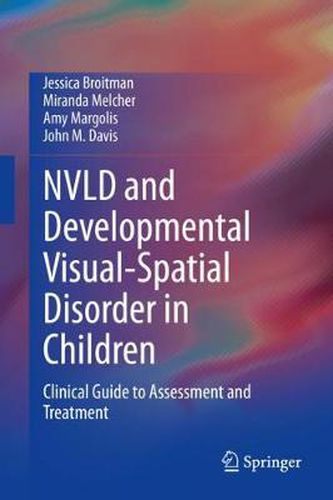Readings Newsletter
Become a Readings Member to make your shopping experience even easier.
Sign in or sign up for free!
You’re not far away from qualifying for FREE standard shipping within Australia
You’ve qualified for FREE standard shipping within Australia
The cart is loading…






This title is printed to order. This book may have been self-published. If so, we cannot guarantee the quality of the content. In the main most books will have gone through the editing process however some may not. We therefore suggest that you be aware of this before ordering this book. If in doubt check either the author or publisher’s details as we are unable to accept any returns unless they are faulty. Please contact us if you have any questions.
This unique volume explores issues related to working with children who have nonverbal learning disability (NVLD). It examines how a child’s psychology - thoughts, feelings, beliefs - affects his or her functioning and learning. In addition, the book addresses how a child’s experiences are processed through individual personality, psychology, culture, environment and economic circumstances, and family dynamics. Using these psychological organizing principles, the book describes how to work most effectively with young patients with NVLD. It offers a new model and definition for understanding NVLD, emphasizing its core deficit of visual-spatial processing.
In addition, this book addresses efforts to rename NVLD to developmental visual-spatial disorder (DVSD). It describes the 11 possible subtypes as including a primary deficit in visual-spatial processes and impairment in several additional functional domains, including executive functioning, social/emotional deficits, academic achievement, and motor coordination. The book highlights the need for psychologically minded treatment and provides specific intervention guidelines. It details how to conduct the intake process and create a treatment plan and team and offers practical suggestions for working with a patient’s family members. In addition, the book addresses the importance of working with a consistent psychological theory, such as control mastery theory (CMT). It describes the Brooklyn Learning Center Model for treating NVLD and offers guidelines for interventions to support patients academically. The book provides a comprehensive approach to the neuropsychological assessment of NVLD as well as examples of visual-spatial, sensory perception, executive functioning, academics, social/emotional deficits and motor coordination interventions, and all forms used to gather information from patients.
Key areas of coverage include:
Definition of nonverbal learning disability (NVLD). Efforts toward inclusion in the Diagnostic and Statistical Manual (DSM) and for renaming it to a developmental visual-spatial disorder (DVSD) Guide to general diagnostic testing and assessment. Developing a treatment plan and team for NVLD patients. NVLD therapy and tutoring priorities.
NVLD and Developmental Visual-Spatial Disorder in Children is an essential reference for clinicians, therapists, and other professionals as well as researchers, professors, and graduate students in school and clinical child psychology, special education, speech-language therapy, developmental psychology, pediatrics, social work as well as all interrelated disciplines.
$9.00 standard shipping within Australia
FREE standard shipping within Australia for orders over $100.00
Express & International shipping calculated at checkout
This title is printed to order. This book may have been self-published. If so, we cannot guarantee the quality of the content. In the main most books will have gone through the editing process however some may not. We therefore suggest that you be aware of this before ordering this book. If in doubt check either the author or publisher’s details as we are unable to accept any returns unless they are faulty. Please contact us if you have any questions.
This unique volume explores issues related to working with children who have nonverbal learning disability (NVLD). It examines how a child’s psychology - thoughts, feelings, beliefs - affects his or her functioning and learning. In addition, the book addresses how a child’s experiences are processed through individual personality, psychology, culture, environment and economic circumstances, and family dynamics. Using these psychological organizing principles, the book describes how to work most effectively with young patients with NVLD. It offers a new model and definition for understanding NVLD, emphasizing its core deficit of visual-spatial processing.
In addition, this book addresses efforts to rename NVLD to developmental visual-spatial disorder (DVSD). It describes the 11 possible subtypes as including a primary deficit in visual-spatial processes and impairment in several additional functional domains, including executive functioning, social/emotional deficits, academic achievement, and motor coordination. The book highlights the need for psychologically minded treatment and provides specific intervention guidelines. It details how to conduct the intake process and create a treatment plan and team and offers practical suggestions for working with a patient’s family members. In addition, the book addresses the importance of working with a consistent psychological theory, such as control mastery theory (CMT). It describes the Brooklyn Learning Center Model for treating NVLD and offers guidelines for interventions to support patients academically. The book provides a comprehensive approach to the neuropsychological assessment of NVLD as well as examples of visual-spatial, sensory perception, executive functioning, academics, social/emotional deficits and motor coordination interventions, and all forms used to gather information from patients.
Key areas of coverage include:
Definition of nonverbal learning disability (NVLD). Efforts toward inclusion in the Diagnostic and Statistical Manual (DSM) and for renaming it to a developmental visual-spatial disorder (DVSD) Guide to general diagnostic testing and assessment. Developing a treatment plan and team for NVLD patients. NVLD therapy and tutoring priorities.
NVLD and Developmental Visual-Spatial Disorder in Children is an essential reference for clinicians, therapists, and other professionals as well as researchers, professors, and graduate students in school and clinical child psychology, special education, speech-language therapy, developmental psychology, pediatrics, social work as well as all interrelated disciplines.